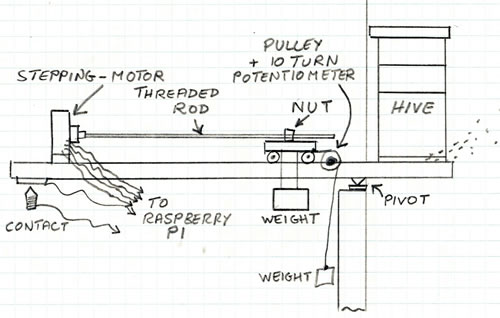
The trolley wheels are from a toy.
The pivot is steel angle iron with the right angle bend pointing down and sitting on a flat metal plate.
More backup notes for a bad memory - - -
(Not finished but working!)
A beehive scales for measuring honey flow
Objective
Observe the hour to hour flow of honey into a beehive - just for interest!
Method
Use a balance similar to a farm yard scale sensitive to 1/10th pound by means of a stepping motor and trolley weight on a balance bar.
Because the hive is just outside a greenhouse wall I can house the scales mechanism inside the greenhouse.
It is like this -

The trolley wheels are from a toy.
The pivot is steel angle iron with the right angle bend pointing down and sitting on a flat metal plate.
The balance bar is a fence post.
An aluminium tube between the trolley wheels keeps it on track.
The large water carrier below is a 20lb weight ! (not connected at present)
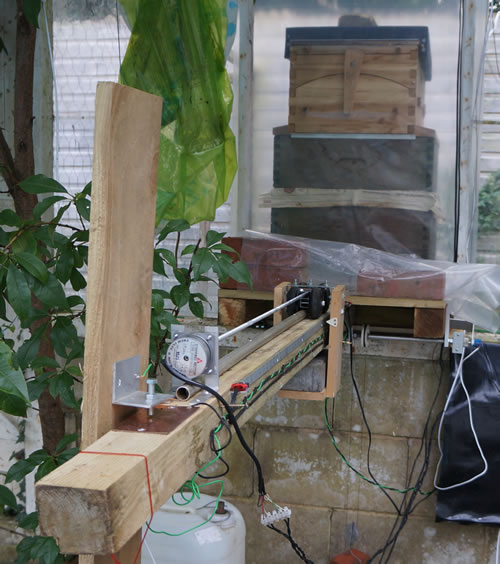
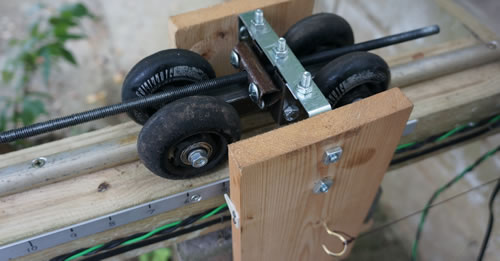

A Raspberry Pi drives a 4 wire stepper motor (from a scrap printer) which
moves the trolley weight back and forth along the bar until the system balances.
This point is detected when the contact beneath the end of the bar just loses connection.
I originally had contacts top and bottom but of course only one is needed. The bar is constrained to only move a few mm up or down.
The position along the bar was originally detected by counting stepper motor pulses.
However if the system crashes the count is lost. I now use a pulley wheel that turns a ten turn potentiometer and this retains a "memory" of the trolley position. The trolley can cover 30lb from one end of the traverse to the other. If it gets to the end a weight will be added to the end of the bar such that the trolley starts again at zero. (Note the hanging brick used to zero the system)
Limit micro-switches turn off the stepper motor power if the trolley hits the end stops.
The aluminium scale is marked in pounds for local reference. I may increase the trolley weight to give a scale from 0 to 60 pounds - but the 2016 summer in the UK is all rain!!
Circuit
The potentiometer is read by an ADS1115 4 channel 16bit AtoD (£2 - eBay - perfect for a Pi!) that is connected to the Pi by the i2c bus.
The balance contacts are connected to ground and to GPIO27
which is pulled to +3.3V by a 6Kohm resistor.
The Raspberry Pi is also used to measure the temperature of a swimming pool, the pool greenhouse air temperature and the temperature of a solar thermal panel used to heat the pool. I also plan to build a spectrum analyzer to see if the tone of a swarm can trigger a warning ( . . . later!)
Stepper driver
Listed as "Dual-H-Bridge-Stepper-Motor-Drive-Controller-Board-Module-For-Arduino-L298N-FT1"
I have tested two versions of ADS1115
both seem identical in use but the smaller board above is cheaper and takes less room.
The ten turn potentiometer - about 3 turns are in use with the pulley I found in my stock (an old plastic toy wheel with tyre removed)
listed as "2pcs 3590S-2-103L 10K Ohm 10-Turn Rotary Wire Wound Precision Potentiometer Pot"
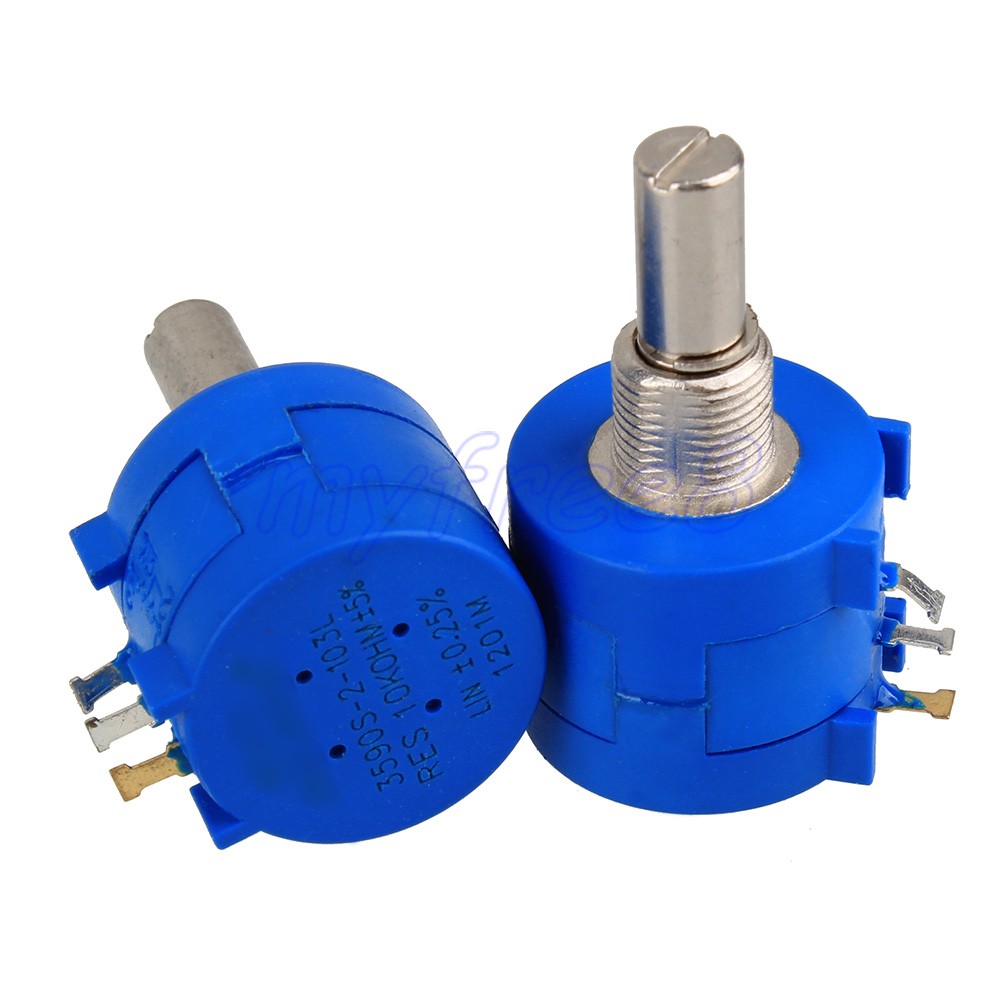
All the above are easy to find on eBay etc.
Results
The system is crude and bulky but the measurements are very stable and it can see weight changes of 1/10th pound.
See the blue line below - not a good day for the bees !
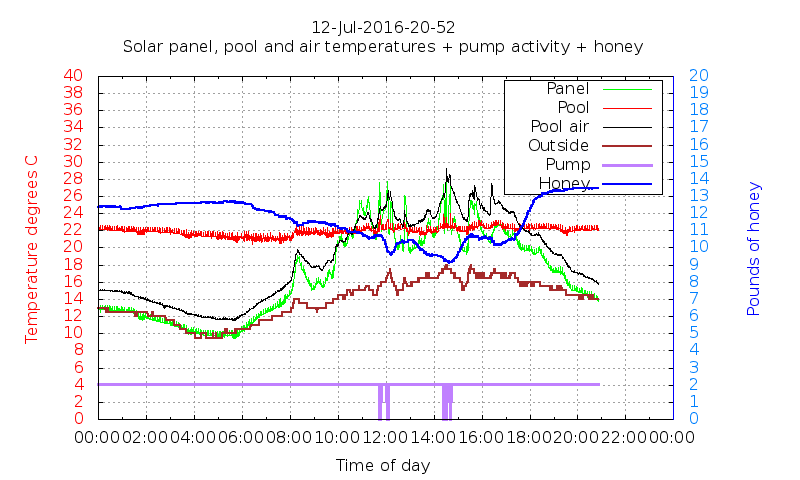
- another plot of the honey weight -
- very little potentiometer noise (it is a wire wound pot) and an absolute, non-drifting measurement ! -
(a smaller pulley would halve the pot noise - only 3 turns used of the 10 available)
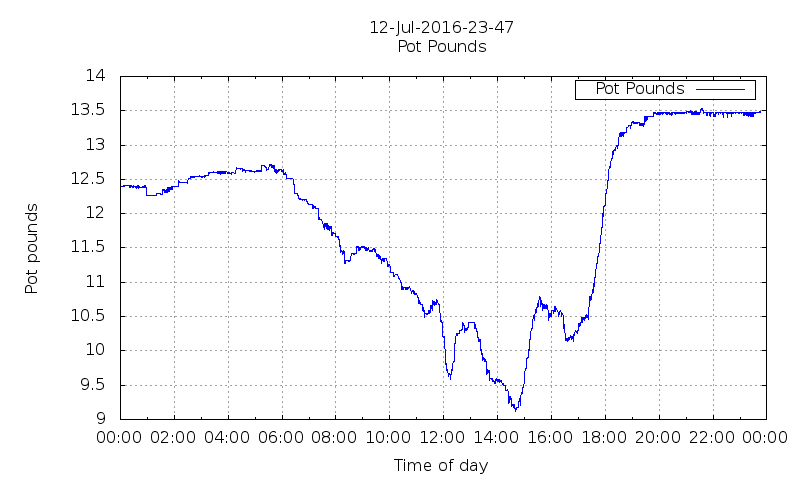
Software
TMP36 thermometers give very smooth plots using the 16bit AtoD.
(currently in use only for the pool air - thin black line in plot above)
Gnuplot makes plotting the data very simple.
Commented software currently in use (and working!) is here
Please email me if you want to swap notes